The world of search is undergoing its most significant transformation since the advent of Google itself. At a recent HiveMCR event in Manchester, I shared critical insights into this shift, exploring where we stand with AI search and what SEO professionals can do about it.
We are currently in a pivotal time for search. Generative AI services are starting to impact search purposes, with Apple even noting a fall in Google searches in Safari due to this shift (though Google has reportedly denied this).
Beyond this, the SEO landscape is seeing traffic decreases attributed to Google’s AI Overviews (AIOs) and other increasing SERP Features. Google seems to be reacting, for example, by including links in AI Overviews, which appears to be increasing pages per visit for them.
While this might benefit Google, it presents a challenge for website traffic, making it a broader web issue, not just one for Google or SEO. This uncertainty is leading to issues with buy-in and resources, making it harder than ever to achieve goals and sell SEO services.
How can we move forward? Let’s answer key AI search questions with data:
- How LLMs & AI search are really affecting Google traffic?
- What are the opportunities for SEOs within AI search?
- How can we make the most out of these opportunities?
The Current Reality: AI Traffic is Still Small
Despite the buzz, data shows that AI traffic is still tiny for most sites compared to traditional organic search. It currently represents only 1-2% of referral traffic for the majority of websites. The revenue potential from AI search is also presently trivial compared to traditional search.
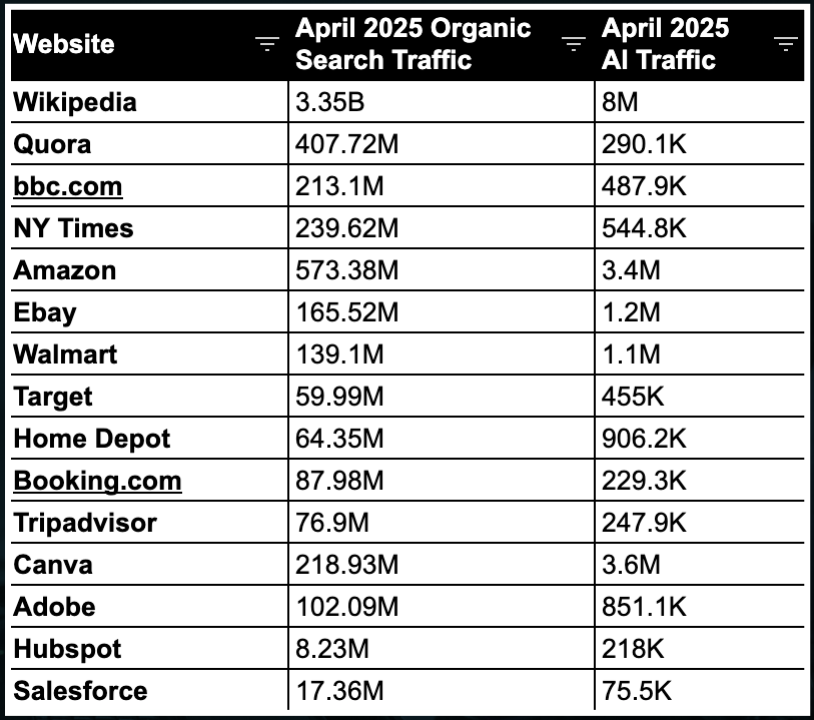
Furthermore, data suggests that users are not ditching Google entirely for new AI platforms like ChatGPT or Perplexity. Instead, most users are employing them as additional platforms.
A significant 98.1% of ChatGPT desktop visitors are also shared with Google, with only 1.9% being exclusive. Similarly, 98.2% of Perplexity visitors are shared with Google, leaving only 1.8% exclusive.
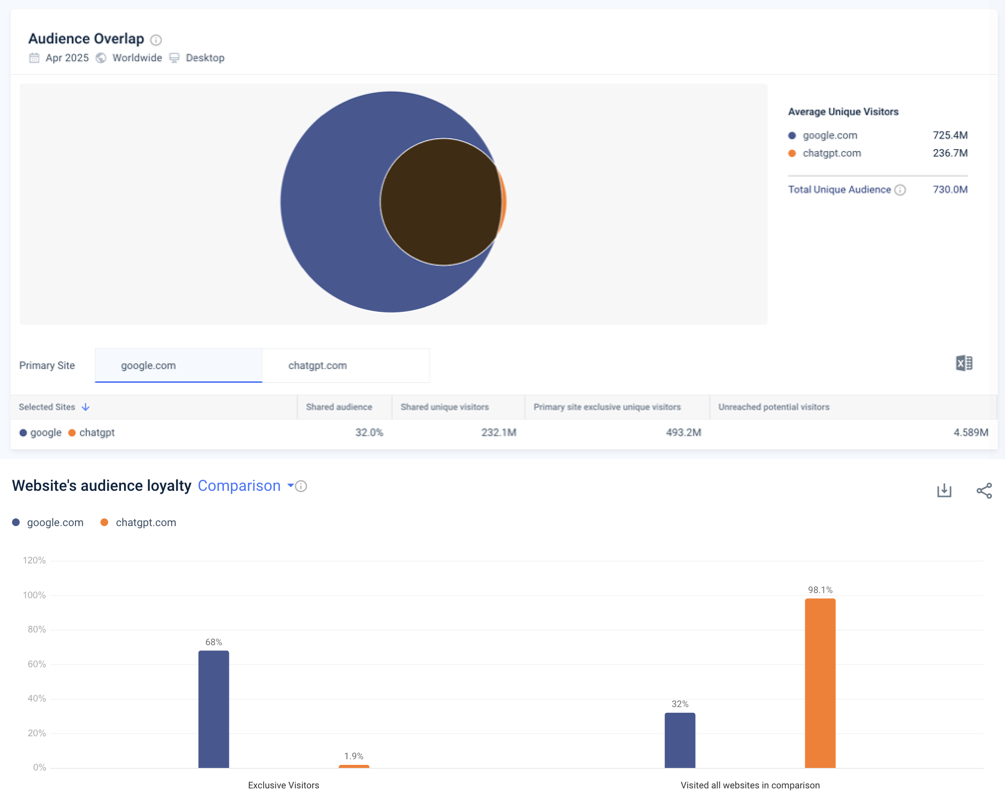
While ChatGPT traffic is growing, it’s still minimal compared to Google (5.14B vs 81.31B visits in April 2025). Google has experienced a slight yearly traffic decrease (-0.89% YOY), but it’s Bing that has seen a much larger drop (-21.76%) in the last year.
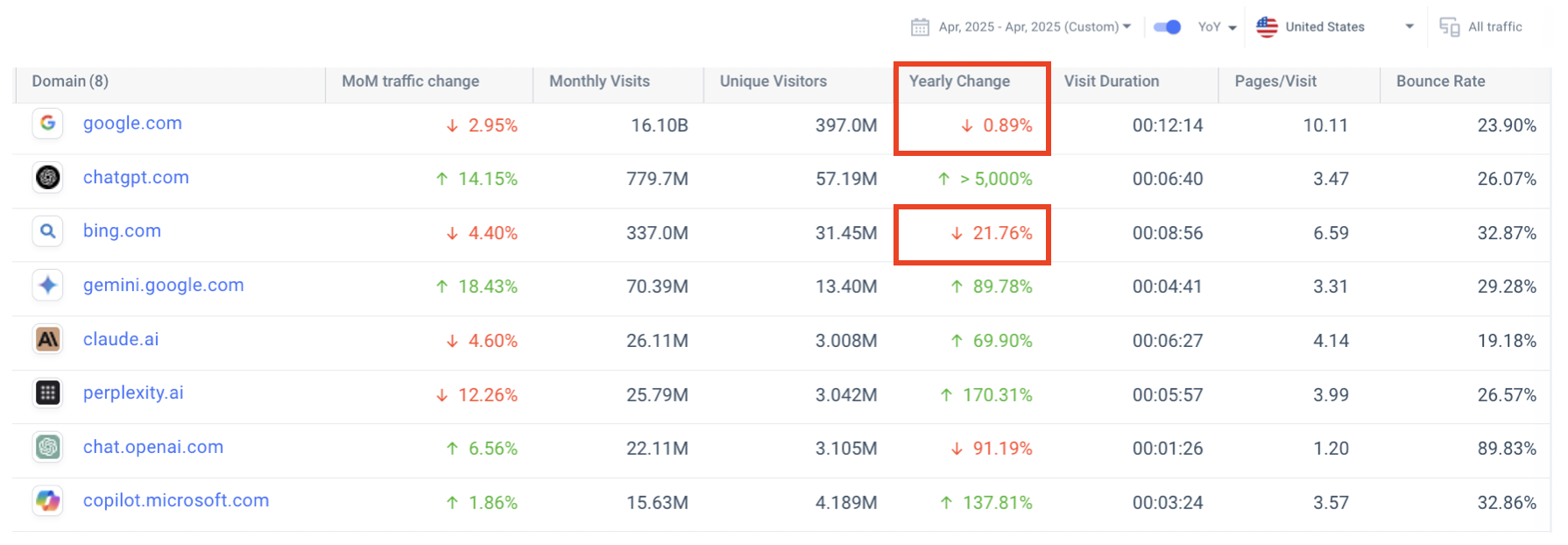
Google holds significant advantages with its product, business, user data, and loyalty. They are actively accelerating releases to catch up with the “first mover” advantage held by OpenAI/ChatGPT. Even Sam Altman from OpenAI reportedly doesn’t believe ChatGPT will replace Google.
Let’s summarize:
- LLMs Traffic and Referral Traffic from LLM’s to sites are growing but still tiny in comparison to traditional search (1-2% referral).
- People are not ditching Google for ChatGPT or Perplexity but using them as additional platforms.
- Google had just a -0.89% yearly traffic decrease while Bing had a -21.76% one.
Google won’t let ChatGPT win the AI search race without leveraging its user and product data advantage, they’re catching up with OpenAI/ChatGPT “first mover” advantage, accelerating releases, and even Sam Altman from OpenAI doesn’t think ChatGPT will replace Google.
But I also thought we actually wanted to have a more diverse search landscape too and disliked Google Monopoly right? We’re difficult to understand, I know. Let’s imagine we’re already in 2030…
A Glimpse into 2030 (Speculative)
Imagine looking ahead to 2030. A future where all search platforms have transitioned to an “AI Agent First Experience”. This experience is envisioned as Predictive, Conversational, Personalized, and Multimodal, importantly linking prominently to sources, improved from the initial AI Overviews. By this time, Google might still hold the majority of the search market share (speculated +50%), with ChatGPT (20%), Bing (15%), Perplexity (10%), and others (5%) also having notable shares.
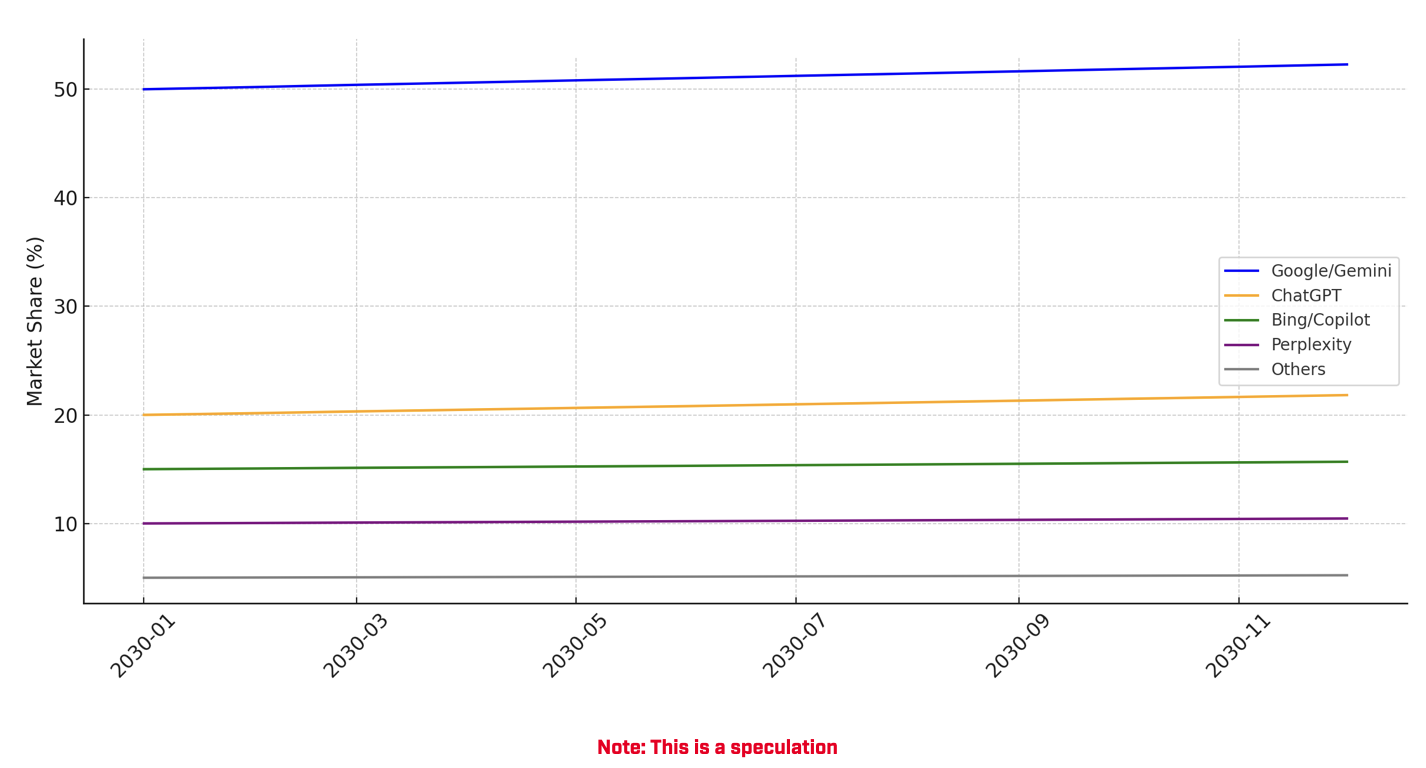
In this potential future, younger users might continue to prefer social platforms like TikTok for discovery, empowered by AI search features. Most users would still utilize search engines like Google or Perplexity with AI enhancements that personalize the interface based on the query. Others might prefer LLMs like ChatGPT or Gemini as their primary search and assistant platforms for complex informational tasks.

By 2030, SEOs should have first-party access to LLM query and performance data, understanding their impact and behavior to develop differentiated strategies for each platform.
The focus would shift to primarily tracking brand visibility, citations, and revenue across various LLMs and search platforms. SEOs would realize they are findability specialists capable of connecting businesses with their target audience on whatever platform they use, celebrating that not all their efforts are concentrated on a single platform anymore.
Perfect! Nothing to worry about. Let’s go back to 2025 to understand how to get prepared and make the most out of the new AI search reality.
Back to 2025: Understanding AI Overviews
Returning to the present, Google has spent the last year rolling out and testing AI Overviews (AIOs). Research indicates that AIOs can harm Click-Through Rate (CTR) and traffic, even for sites featured within them.
However, it’s important to note that AIOs are primarily shown for informational queries, where a summary is more helpful than for commercial or transactional ones. AIO inclusion varies significantly by industry too, being high in Health but minimal in e-commerce.

Also, while AIOs are appearing more often for commercial queries, in the recent research performed by Kevin Indig, they found that 80% of users searching for commercial/transactional terms still click on non-AIO results.
So, for most businesses (unless they are publications monetizing through ads or affiliates), the queries most impacted are broad informational and navigational terms, not typically the money-making ones. Branded and navigational queries are more likely to still drive traffic.
As you can see, context plays a major role but for most SEOs their own AIO’s impact is still unclear since assessment is not straight-forward without a Google Search Console filter. However, it is doable and critical:
- I show how to do the before/after AIOs traffic impact analysis in this video here, whether you’re included in the snapshot or not.
- I highly recommend to monitor AIOs and other SERP Features traffic via GA4 too as described by Dana DiTomaso here.
- Start tracking pixel visibility in SERPs using rank trackers that have this feature like Advanced Web Ranking, rather than just positions.
This will allow you decide which are the AIO’s worth pursuing for inclusion & what to target instead:
- How relevant & popular are these queries for your customers buying journey?
- What’s the impact on your brand visibility and authority recognition toward a relevant audience?
- What’s the impact on potential sales? Revenue?
- What’s the impact on customers support? Operational Cost?
You should use these not only for AIO’s potential assessment but any LLMs and search platforms. Remember that it’s also about brand recognition, authority and trust building too.
Optimizing for the AI Search Era
So, what if you decide to target and optimize for AIOs and other LLMs? AIOs differ from traditional LLMs as they are designed to be grounded in information from the web, powered by Gemini 2.0, and integrated with Google’s ranking systems and knowledge graph. Google’s official stance is that no additional optimization is needed beyond general search guidelines for AIOs. However, this isn’t entirely helpful advice, of course.
Data shows that 52% of AIO citations are not even within the top 50 traditional results, and 29% link to more Google properties.
Research from Profound has also shown that there’s also only a 12% overlap between Google’s traditional search results and the sources used in ChatGPT answers. Different LLMs show distinct preferences in sourcing information.
Although the pillars of traditional search and LLMs optimization are shared, optimizing for search-integrated LLMs has some key differences compared to traditional search:
- Some LLMs, like ChatGPT and Claude, do not execute JavaScript (unlike Gemini), making Server-Side Rendering (SSR) critical for important content to appear in their answers.
- Page experience is also not a direct ranking factor for LLMs unlike traditional search results that take them into account.
- Citations play a much bigger role for LLMs than for traditional search results.
Beyond technical considerations, enhancing content semantic relevance and entity recognition is even more important than before with LLMs, although also important to optimize content for modern search engines. Identifying topic gaps, improving topical authority, and refining content structure and relationships are key. Establishing your brand visibility and recognition is vital too.
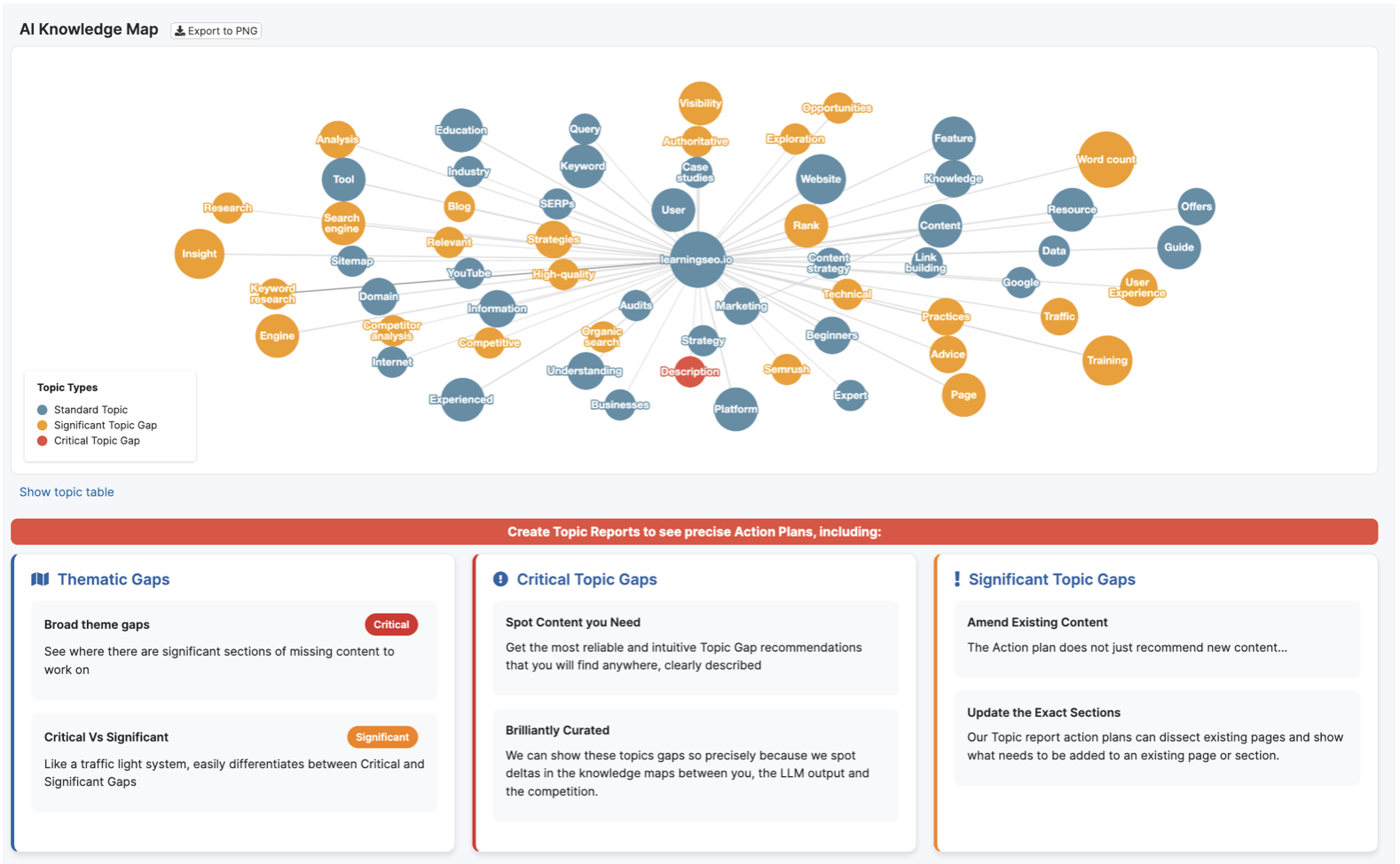
The biggest changes between LLMs vs traditional search are observed in user behavior: the length, complexity, nature of queries, topics searched, and interaction styles. This is why it’s crucial to start monitoring LLM prompts and the content they trigger, in addition to AIOs, which is now possible thanks to Similarweb new AI Chatbot traffic report.
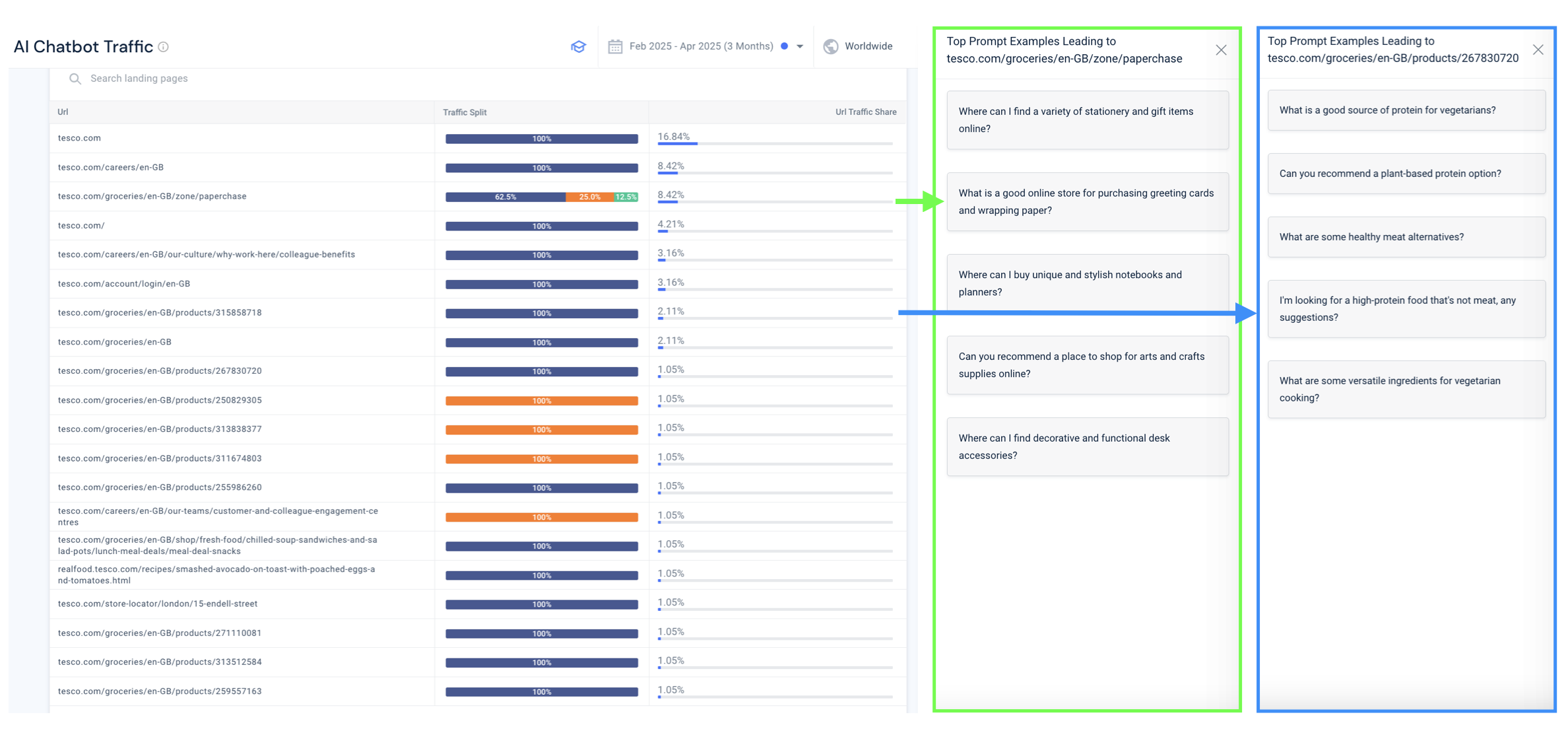
Key Performance Indicators (KPIs) also change. Traditional rankings are not relevant in LLMs. Instead, success should be measured by brand citations in sources or brand mentions and links within the LLM answers.
It’s recommended to start tracking your brand’s inclusions, links, and citations versus competitors in each target LLM, and to monitor the relevant players and popular prompts per topic on each platform, which is possible thanks to tools like Waikay, Rankscale, or Peec.ai, and Dejan AI Rank.
This is important because different models cite different sources for the same questions, data from Profound shows a major difference in AIO’s & ChatGPT sources: Only 21% domains & 9.9% URLs overlap. Each LLM shows different preference patterns when sourcing information, which is also recommended to take into account.
For example, based on James Allen research we can see ChatGPT heavily skews toward established, authoritative, and factual sources, not featuring much UGC. However, Gemini blends authoritative sources (blogs, news) with community input.
![]()
The clearest takeaway is that our existing SEO skills are transferable, and the rise of AI search simply means there is now a broader pool of platforms through which to connect with our audience. Even Google reportedly agrees with this.
This shift raises an interesting question: are we still doing “SEO” or something else? Those who optimize for YouTube or TikTok search are arguably doing a form of SEO; optimizing for LLMs and AI search features fits into this evolving definition, and the way we call it will have to do more with market demands and how we package the services.
The call to action is clear: start monitoring, analyzing, and adapting. By understanding the nuances of AI search features like AIOs and the behavior of different LLMs, SEOs can prepare and make the most of this new reality. We are evolving into findability specialists, ready to navigate the increasingly diverse search landscape.